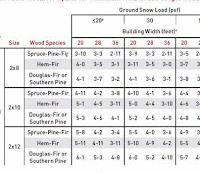 |
| Header Sizing Table (excerpt) |
Whatever the case, it's readily apparent that Leiva had no experience using, much less sizing, headers. José found himself a quality reference (Family Handyman) and mined it for a few factoids, but apparently he didn't even grasp the definition of a header, rendering it as,
"...a block of wood that helps to hold weight over an opening such as a door or window."
That's a rather weak definition of a structural member that transmits and distributes the weight of everything above it – upper floors, roof, and associated loads – into extra framing around the opening. But what the hey: to "hold weight" is probably philosophically correct.
José's chief problem is that he had no idea how headers are sized, so he did little more than attempt to reproduce a chart of header sizes his reference says will support "the roof, ceiling and one center bearing floor of a 28-ft. wide building; [with a] 30-lb. snow load." Apparently nobody's fool, however, José instructed his readers to,
"[Ask] an engineer or the person in charge of local building codes to check your work..."
That's darned good advice, since José's sizing suggestions include such dross as,
"If you are creating an opening no wider than 4 feet, for a door or smaller window, then you need a 2-by-6 header..." and "For an opening 6 to 7 feet wide, you will need two 2-by-12 headers."
It's pretty obvious that Leiva had no clue that sizing a header requires that the designer account for the total load on the bearing wall, expected load on the roof and any floors above the header, lumber species, and framing thickness (among other variables). That doesn't even begin to address the stupidity of telling people they'll need "two 2-by-12 headers" or the fact that longer headers require additional trimmers ("jack studs")! It's obvious that José did not realize that headers are framed on edge or that the "two 2-by-12 headers" he cited is actually a pair of 2-by-12s sandwiched around some half-inch plywood.
Clearly, Leiva did not read all of his Family Handyman article; missing at least the part that said, "The 2000 International Building Code book contains two full pages of mind-numbing charts for calculating proper header sizes in different situations" [see image above]. Clearly...
This is just one more case of a clueless Dumbass of the Day collecting his stipend for fooling an equally clueless Demand Media "content editor" into believing he knew his topic. He didn't...
DDIY - FRAMING
No comments:
Post a Comment